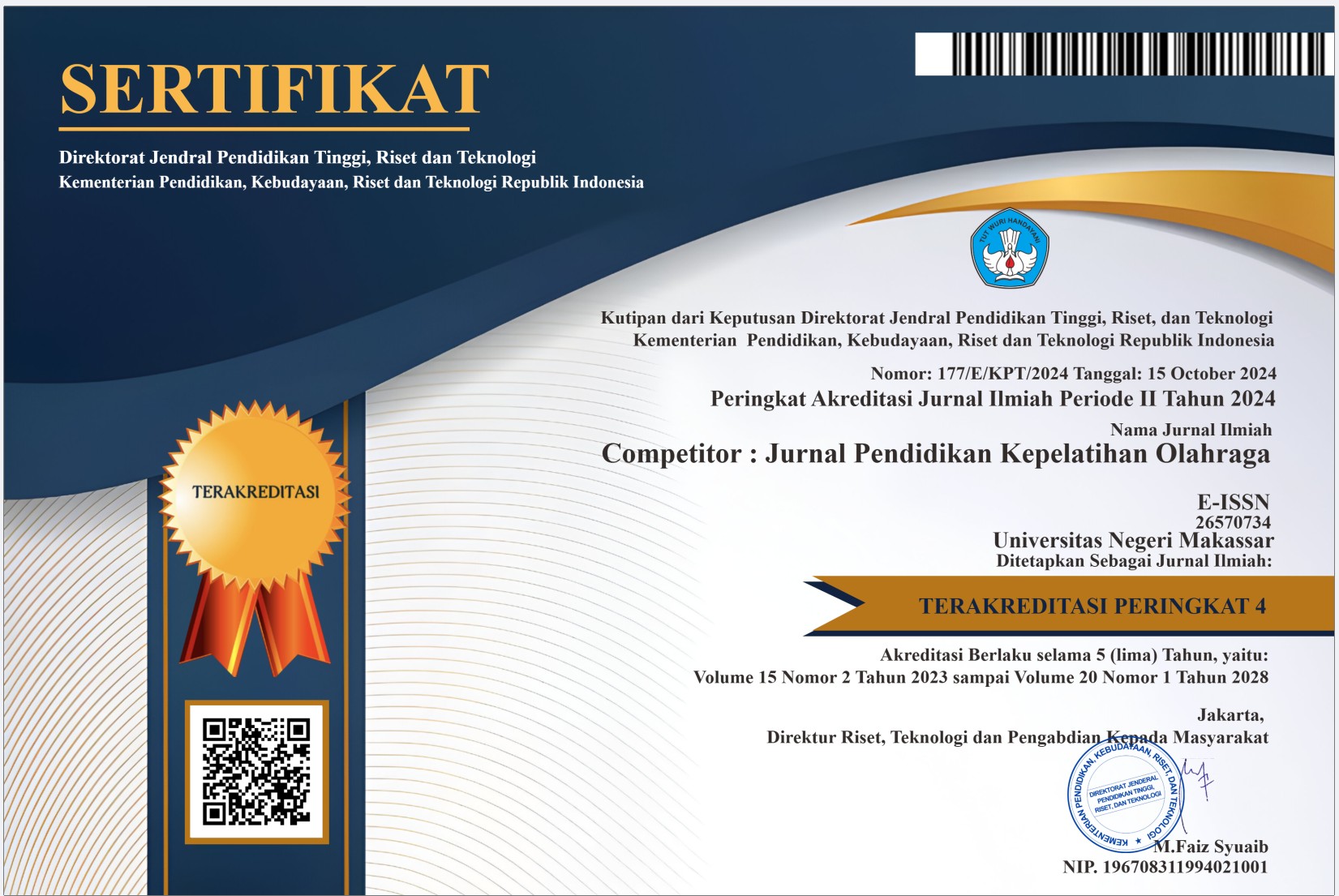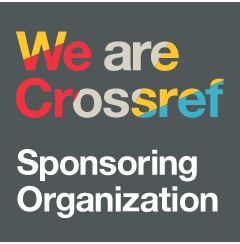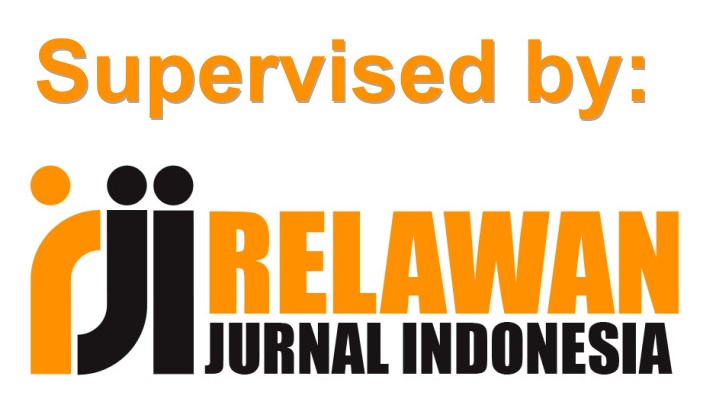The Effect of Small-Sided Games Training on Passing Accuracy in Players Aged 13-15 at Fafage Academy Sumedang
DOI:
https://doi.org/10.26858/cjpko.v17i3.301Kata Kunci:
Small-Sided Games, passing accuracy, futsal, technical training, adolescent players.Abstrak
This study aims to determine the effect of Small-Sided Games (SSG) training on passing accuracy in futsal among players aged 13–15 years at Fafage Academy Sumedang. The main issue addressed in this research is the low passing accuracy among young players, which can negatively impact overall team performance. Small-Sided Games were selected as the training method because they involve fewer players in a smaller playing area, allowing for higher ball-touch frequency and decision-making under conditions that simulate real match situations. This research employed a quantitative method with a pretest-posttest experimental design. The sample consisted of 20 male futsal players aged 13–15 years who actively trained at Fafage Academy Sumedang. Data were collected through passing accuracy tests conducted before and after the intervention. Data analysis included normality, homogeneity, paired sample t-test, and R-Square tests using SPSS version 26. The results showed an increase in the mean score from 4.05 in the pre-test to 6.65 in the post-test. The paired sample t-test revealed a significance value of 0.000 < 0.05, indicating a significant effect of SSG training on passing accuracy. The R-Square value indicated that the training contributed 24% to the improvement, while the remaining 76% was influenced by other factors. In conclusion, Small-Sided Games training proved to be effective in improving passing accuracy in futsal for adolescent players and is recommended as a practical approach in technical training programs for youth academies.
Referensi
Akina, W., & Lee, S. S. (2016). Kesan teaching games for understanding (TGFU) terhadap hasil pembelajaran dalam permainan mini hoki. http://studentsrepo.um.edu.my/7012/
Amani-Shalamzari, S., Khoshghadam, E., Donyaei, A., Parnow, A., Bayati, M., & Clemente, F. M. (2019). Generic vs. small-sided game training in futsal: Effects on aerobic capacity, anaerobic power and agility. Physiology & Behaviour, 204, 347–354. https://doi.org/10.1016/J.PHYSBEH.2019.03.017
Ames, H. M. R., Ames, H. M. R., Glenton, C., Lewin, S., & Lewin, S. (2019). Purposive sampling in a qualitative evidence synthesis: A worked example from a synthesis on parental perceptions of vaccination communication. BMC Medical Research Methodology, 19(1), 1–9. https://doi.org/10.1186/S12874-019-0665-4
Balyan, M., & Vural, F. (2018). Futsal World Cup: Differences Created by Winning, Losing and Drawing Variables in Scored Goals and Offensive Variations. Journal of Education and Training Studies, 6(5), 65–71. https://doi.org/10.11114/JETS.V6I5.3147
Bronner, S., Pinsker, R., Naik, R., & Noah, J. A. (2016). Physiological and psychophysiological responses to an exer-game training protocol. Journal of Science and Medicine in Sport, 19(3), 267–271. https://doi.org/10.1016/J.JSAMS.2015.03.003
Clemente, F. M., Sousa, P. M., Pinheiro, V., & Santos, F. J. (2017). How and why do soccer coaches use small-sided games in the training process? Human Movement, 2017(5), 117–124. https://doi.org/10.5114/HM.2017.73624
Deksano, F., Erfiandhi, D. R., Prasetya, A. C., Patmuryanto, A. S. N., & Warnars, H. L. H. S. (2021). Mobile application for the futsal sports community in Jakarta. International Conference on Artificial Intelligence, 741–746. https://doi.org/10.1109/ICAIS50930.2021.9395853
Denami, M. (2018). Serious Game-Based Learning: The Place of Users’ Verbalization in The Acquisition of Specific Skills. International Journal of Training and Development, 22(2), 144–161. https://doi.org/10.1111/IJTD.12123
Fikri, S., Pradhila, F., & Dirganta, D. (2016). Biomechanical analysis with optimal combination by using the foot and distance when the futsal player passing the ball against the accuracy of the target. British Journal of Sports Medicine, 50(22). https://doi.org/10.1136/BJSPORTS-2016-096952.20
Frikha, M., Chaâri, N., Derbel, M. S., Elghoul, Y., Zinkovsky, A. V., & Chamari, K. (2017). Acute effect of stretching modalities and time-pressure on accuracy and consistency of throwing darts among 12- and 13-year-old schoolboys. Journal of Sports Medicine and Physical Fitness, 57(9), 1089–1097. https://doi.org/10.23736/S0022-4707.16.06521-X
Galliera, A. (2016). Adaptation dynamics in individual and strategic behaviour: an experimental analysis.
Gioldasis, A. (2016). A Review of Anthropometrical, Physiological, Psychological and Training Parameters of Futsal. International Journal of Science, Culture and Sport, 4(3), 240–259. https://doi.org/10.14486/INTJSCS500
Goes, F. R., Kempe, M., Meerhoff, L. A., & Lemmink, K. A. P. M. (2019). Not Every Pass Can Be an Assist: A Data-Driven Model to Measure Pass Effectiveness in Professional Soccer Matches. 7(1), 57–70. https://doi.org/10.1089/BIG.2018.0067
Hammami, A., Gabbett, T. J., Slimani, M., & Bouhlel, E. (2017). Does small-sided games training improve physical fitness and team-sport-specific skills? A systematic review and meta-analysis. Journal of Sports Medicine and Physical Fitness, 58(10), 1446–1455. https://doi.org/10.23736/S0022-4707.17.07420-5
Hasan, U. Ch., & Clemente, F. M. (2021). Relationship Between Passing and Ball Control in Soccer: Analysis of Variations of Kinematic Measures. Polish Journal of Sport and Tourism, 28(1), 3–7. https://doi.org/10.2478/PJST-2021-0001
Islam, M. S. (2022). Small-Sided Conditioned Games: A Drill for Overall Player Development in Soccer. International Journal of Sport, Exercise and Health Research, 6(1), 97–98. https://doi.org/10.31254/sportmed.6116
Lach, E. (2017). Dynamic Difficulty Adjustment for Serious Game Using Modified Evolutionary Algorithm (pp. 370–379). Springer, Cham. https://doi.org/10.1007/978-3-319-59063-9_33
Lubis, L., Muhammad, A. M., & Nandina, O. (2019). Role of Physical and Cognitive Factors in Passing Abilities of Futsal Athletes in Universitas Padjadjaran. Majalah Kedokteran Bandung, 51(2), 104–109. https://doi.org/10.15395/MKB.V51N2.1578
Mace, M., Kinany, N., Kinany, N., Rinne, P., Rayner, A., Bentley, P., Burdet, E., & Burdet, E. (2017). Balancing the playing field: collaborative gaming for physical training. Journal of Neuroengineering and Rehabilitation, 14(1), 116. https://doi.org/10.1186/S12984-017-0319-X
Machado, A. A., Bezerra, I. S., Ponciano, K. R., Rica, R. L., Gama, E. F., Junior, A. F., Gimenez, R., & Bocalini, D. S. (2018). Futsal as a strategy for the improvement of elementary abilities and for the development of body image in children. Motricidade, 14, 11–19. https://doi.org/10.6063/MOTRICIDADE.12299
Milioni, F., Palucci Vieira, L. H., Barbieri, R. A., Zagatto, A. M., Nordsborg, N. B., Barbieri, F. A., dos-Santos, J. W., Santiago, P. R. P., & Papoti, M. (2016). Futsal Match-Related Fatigue Affects Running Performance and Neuromuscular Parameters but Not Finishing Kick Speed or Accuracy. Frontiers in Physiology, 7, 518. https://doi.org/10.3389/FPHYS.2016.00518
Muzaffar, A., & Saputra, A. (2019). Pengaruh latihan small sided game terhadap akurasi passing pada siswa ekstrakulikuler futsal smp negeri 1 muaro jambi. 1(2), 81–88. https://doi.org/10.22437/IJSSC.V1I2.7605
Oppici, L., Panchuk, D., Panchuk, D., Serpiello, F. R., Farrow, D., & Farrow, D. (2018). The influence of a modified ball on the transfer of passing skill in soccer. Psychology of Sport and Exercise, 39, 63–71. https://doi.org/10.1016/J.PSYCHSPORT.2018.07.015
Queiroz, V. M., Ornstein, S. W., & Elali, G. A. (2021). Research instruments on environmental quality applied to small children with Down Syndrome. Ambiente Construído, 21(1), 197–216. https://doi.org/10.1590/S1678-86212021000100502
Ridwan, M., Darmawan, G., & Fuadi, Z. (2018). Small-sided games in football as a method to improve high school students’ instep passing skills. 296(1), 012018. https://doi.org/10.1088/1757-899X/296/1/012018
Santos-Silva, P. R., D’Andrea Greve, J. M., Espada Novillo, H. N., Haddad, S., Pinto dos Santos, C. R., Barco Leme, R., Rocha Franco, R., Cominato, L., Teixeira Miranda Araújo, A., Miranda Santos, F., Damiani, D., Luksevicius Rica, R., & Sales Bocalini, D. (2018). Futsal improves body composition and cardiorespiratory fitness in overweight and obese children. A pilot study. Motriz-Revista De Educacao Fisica, 24(3). https://doi.org/10.1590/S1980-657420180003E003618
Saputra, S. Y., & Tangkudung, J. (2015). Development of the passing controlling exercise model in futsal for junior high school students. 1(1), 21–31. https://doi.org/10.21009/JIPES.011.03
Savu, V.-C., & Moisescu, P. C. (2017). Experiment on the Improvement of the Playing Technique of ”C” Juniors in the Football Game. Gymnasium, 2, 101–112. https://doi.org/10.29081/GSJESH.2017.18.2.07
Scofield, D. E., & Kardouni, J. R. (2015). The Tactical Athlete: A Product of 21st Century Strength and Conditioning. Strength and Conditioning Journal, 37(4), 2–7. https://doi.org/10.1519/SSC.0000000000000149
Sekiguchi, Y., Honda, K., & Izumi, S. (2023). Postural adjustment in the standing position when catching a ball under unpredictable conditions of the direction to be caught. Heliyon, 9(2), e13138. https://doi.org/10.1016/j.heliyon.2023.e13138
Setyadi, A. (2016). Pengaruh latihan small sided games terhadap keterampilan passing siswa peserta ekstrakurikuler futsal di smp muhammadiyah 2 depok sleman tahun 2016.
Sgrò, F., Bracco, S., Pignato, S., & Lipoma, M. (2018). Small-Sided Games and Technical Skills in Soccer Training: Systematic Review and Implications for Sport and Physical Education Practitioners. Journal of Sports Sciences, 6(1). https://doi.org/10.17265/2332-7839/2018.01.002
Silva, A., Ramirez-Campillo, R., Sarmento, H., Afonso, J., & Clemente, F. M. (2020). Effects of Training Programs on Decision-Making in Youth Team Sports Players: A Systematic Review and Meta-Analysis. Frontiers in Psychology, 12, 663867. https://doi.org/10.3389/FPSYG.2021.663867
Stöckl, M., Cruz, D., & Duarte, R. (2016). Modelling the Tactical Difficulty of Passes in Soccer (pp. 139–143). Springer, Cham. https://doi.org/10.1007/978-3-319-24560-7_17
Travassos, B., Araújo, D., & Davids, K. (2018). Is futsal a donor sport for football?: Exploiting complementarity for early diversification in talent development. 2(1), 66–70. https://doi.org/10.1080/24733938.2017.1390322
Wiriawan, O., & Sukmanda, T. F. (2017). Analisis Speed, Agility, Power, dan Vo2 Max pada Ekstrakurikuler Futsal SMP Negeri 2 Madiun. 2(1), 27–29. https://doi.org/10.26740/JOSSAE.V2N1.P27-29
Yiannaki, C., Carling, C., & Collins, D. (2018). Futsal as a potential talent development modality for soccer – a quantitative assessment of high-level soccer coach and player perceptions. 2(4), 299–308. https://doi.org/10.1080/24733938.2018.1483079
Unduhan
Diterbitkan
Terbitan
Bagian
Lisensi
Hak Cipta (c) 2025 Bimo Erlian, Adang Sudrazat, Entan Saptani (Author)

Artikel ini berlisensi Creative Commons Attribution 4.0 International License.





















